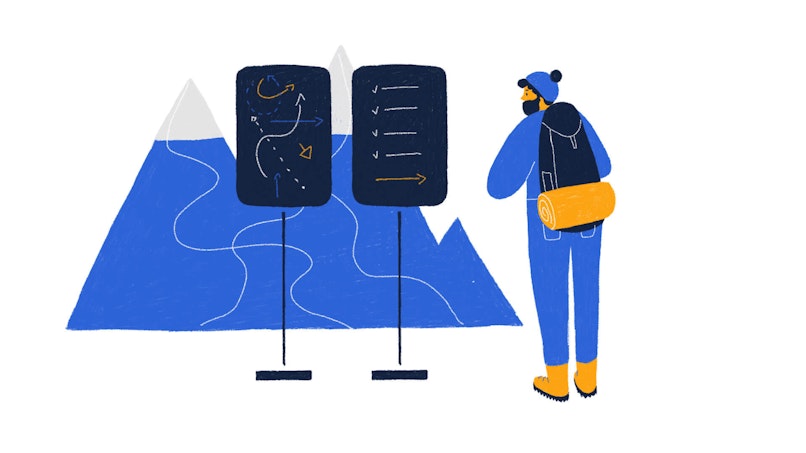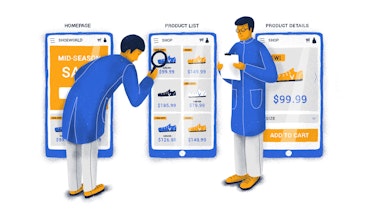Case studies can often feel like a hefty, impenetrable task. Where do you even start? Compressing, structuring, and organizing a few weeks or even months of work in a few hundred words can be quite challenging to many of us.
Fortunately, creating one isn’t really that complicated once you’ve learned the basics—and this is precisely what this article is all about.
Read on to learn about the purpose of a case study and how you should go about creating one. Also, we’ll take a closer look at some valuable tips to get you through your first case study that’ll safeguard you from the most common pitfalls.

Okay, so what are case studies?
Basically, a case study is an in-depth exploration of the decision-making of a person or group of people. The idea behind them is to document the subject’s actions in a particular setting and analyze their behavior and choices.
When writing one, think of yourself as a protagonist in a story or novel. While this may sound somewhat pompous to some, it’s actually a helpful approach to take when creating a case study, and there are a couple of reasons for that.
First off, the point of a case study is to present your thought process and reasoning skills within your field of expertise. While most projects are undoubtedly different, they all have relatively similar phases they go through—the same goes for the types of decisions you make throughout these phases. Being descriptive and analytical about the types of issues you’ve faced as a designer and the solutions you’ve come across is an awesome way of showcasing your skills.
Secondly, storytelling is an extremely powerful persuasion tool—and there’s an extensive body of research to support these claims. People are passionate about stories. We empathize with the characters in the novels we read and the movies we see, to a point where we can drop an occasional tear once in a while. We’ve never seen or known these people, but we still happen to care.
Well, this is all fine and dandy, but why even create a case study in the first place?
What might you need them for?
Case studies are a great way of outlining your qualities as a designer and decision-maker. However, these documents can take a wide array of shapes and sizes.
Designers will often create case studies to showcase their creativity, analytical skills, quantitative reasoning skills, and communication skills during job interviews.
On the other hand, design firms or agencies typically create them to highlight the quality of the services delivered and the impact that they had on the client’s bottom line, market share, or overall success.
What does a UX case study include?
Before discussing structure, we’d like to mention that when working on the first of your case study, don’t focus on length too much. Later, you’ll have the opportunity to trim things down with some visual support. But for now, be as descriptive as you can be with the information that’s relevant to your input in the project at hand. Alright, let’s talk about structure.
1. Outline the task at hand
The purpose of the outline is to provide your reader with a “big picture” understanding of the project. Typically, this section should be fairly brief—think of it as a really quick onboarding.
Here’s a fictitious example:
Project title:Headspace App Redesign
Problem: The Headspace app is continuously losing engagement from its users. Their main areas of concern are:
High uninstall rates
Low OCR
Dwindling MAU
Solution: Rethink Headspace’s content strategy. Design better push notifications. Gamify the experience to create long-lasting meditation streaks.
2. Highlight your role and the process
This section gives you the chance to expand on how you or your team has planned on delivering the solutions outlined above and what your personal contribution was in the grand scheme of things.
For instance, you can state that your responsibilities on this project predominantly revolved around interaction design and visual design.
Then, you can follow it up with a process outline that allows you to highlight the quality of your decision-making. Ideally, the process should abide by modern industry standards.
3. Expand on the outcomes
It’s always a great idea to focus on hard numbers when speaking about outcomes. Of course, the quality of your design will play a significant role in how your work will be appreciated, but at the same time, the people reviewing your case studies are organizations or clients that need solid results. The more specific you can get about the impact your design has had on the clients’ bottom line, the better.
Here are a few examples of outcomes that we’ve presented in some of our case studies:
78% increase in conversion rates. Thanks to better usability, the schools are a lot more likely to upgrade their trial accounts and become paying customers.
4x increase in perceived value. Good-looking apps look more trustworthy and valuable, which is why we’ve invested our time in creating a modern and sleek interface.
Acquisition of new clients. Based on new tailored features and interactive prototypes, we helped acquire big Governmental and Corporate clients.
Reduced costs by 3x: Increased developers’ efficiency and reduced costs by having a user-centered design approach.
It’s always best to focus on actual numbers rather than arbitrary improvements. Your viewpoint as a designer is quite different from a client who probably has a different background and different goals in mind. By sticking with hard numbers, you’ll be able to accentuate the objective value your team or yourself can produce.
Tips for writing a great case study
On the surface, writing a case study may appear simple. I mean, a project outline, the process, and the outcome—nothing complicated there. That’s only partly true. The hard part is creating an impactful and engaging case study. Below, you’ll find some useful recommendations to make your project overview captivating and legible.
Storytelling
We mentioned storytelling above, and we’re going to do it again. Yes, storytelling is an incredibly overlooked part of creating a case study. Your goal here is to be descriptive—you want to get your readers to empathize with you. You want them to feel what you felt at the beginning of the project. Don’t hesitate to create some dramatic tension where you can (but don’t go overboard).
Clear structure
Given that you don’t get too excited with the dramatic tension, you should think of a very clear and easy-to-scan structure for your case study. The person reading it should have a clear understanding of what section they’re reading at all times.
Use bullet points where you can. They help organize the text, make the information much more accessible, and provide your case study with clear information architecture.
Avoid large blocks of text
This is critical. There’s nothing more dissuading than a wall of text with no paragraphs. You’ve probably been there as well, reading something mildly interesting where you see a 20-line paragraph, thinking to yourself “Nah.”
Typically, it’s a good idea to keep your paragraphs up to 5 lines in length, but in a case study, it’s reasonable to even go with less.
Add visuals where you can
Remember the wall of text we mentioned above? That applies to content that doesn’t have visual support as well. There are many reasons why you’d want to include some images in your case study, but the most important ones are:
After all, this is a highlight of your design skills;
You’re providing visual support to your storytelling, making it more compelling and captivating;
You make the text much more accessible by watering down all that text with some media while allows the eyes to rest a bit;
Pet projects work too
Case studies don’t necessarily have to be about “Headspace-tier” redesigns. Feel free to write one about a pet project of yours—the most important part here is highlighting your thought process between a problem and a solution.
Even if you can’t code, you can still showcase, come up with an idea, validate it, and come up with a UX solution. These ideas or problems don’t have to be anything too drastic either. We would suggest picking a struggle that you yourself are dealing with so that you have some insight into it right off the bat.
Seek inspiration
Check out the links below for inspiration:
https://adamfard.com/ux-project
The bottom line
By following the steps above, you’ll be able to knock out an awesome case study while also avoiding the most common pitfalls first-timers face. However, bear in mind that case studies have a wide array of purposes, and you should always adjust them to your particular needs.




